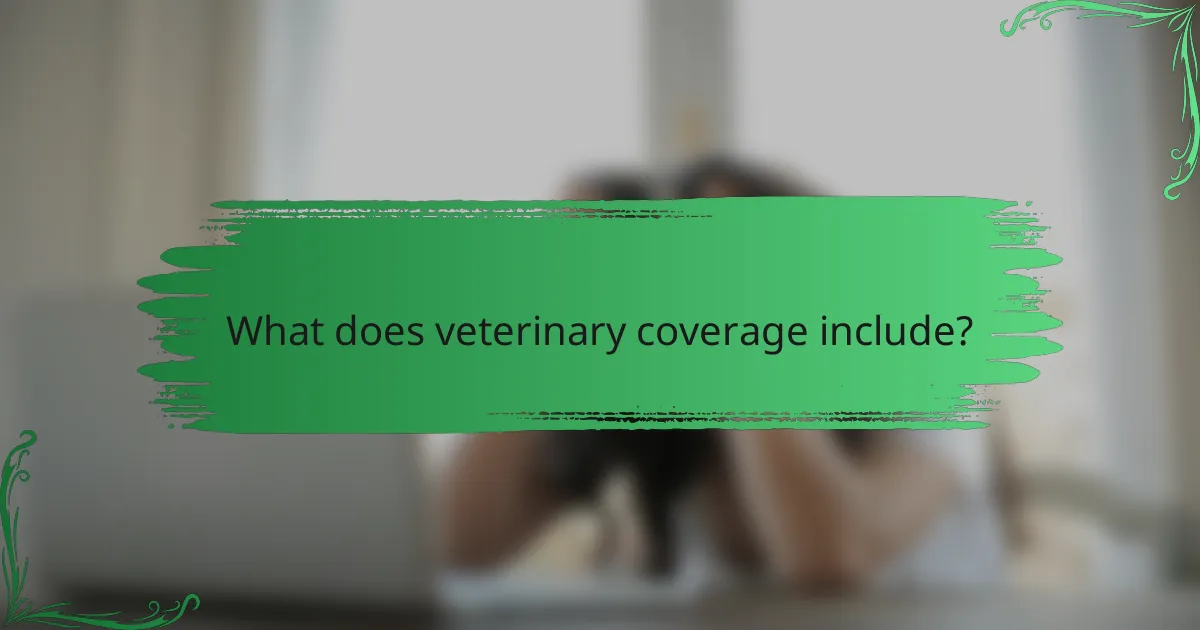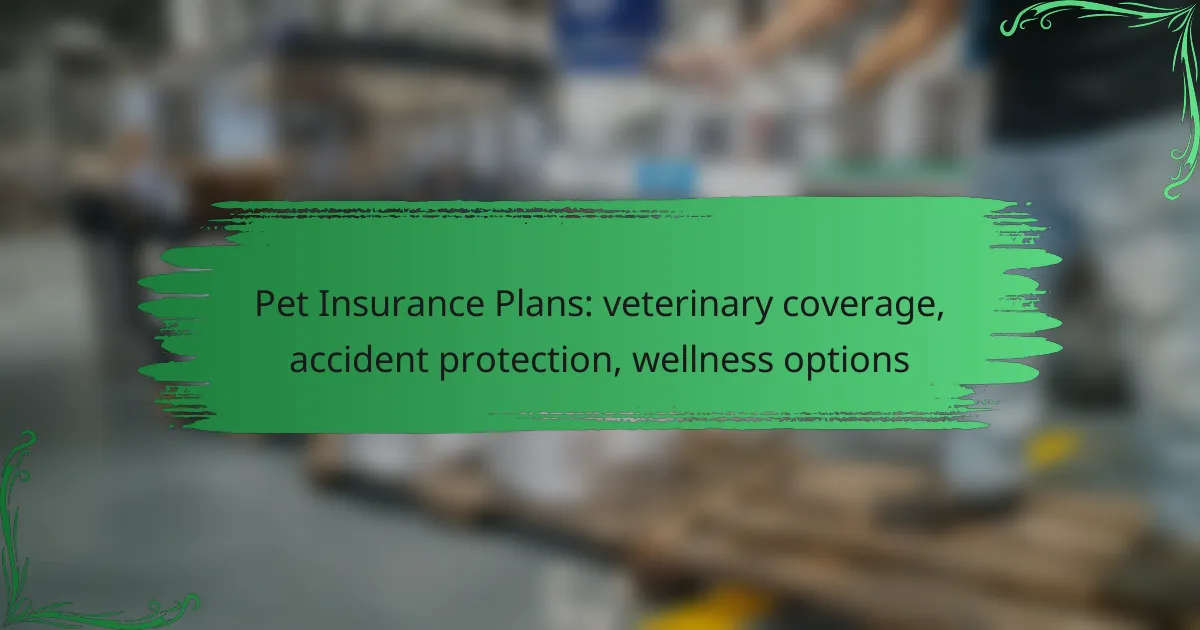Pet insurance plans offer essential protection for your furry companions by covering veterinary expenses, accident-related injuries, and wellness care. With a variety of options available, it’s important to evaluate coverage limits, exclusions, and additional benefits to find the right fit for your pet’s needs. By investing in a comprehensive plan, you can ensure that your pet receives the necessary medical attention without the burden of unexpected costs.

What are the best pet insurance plans in the UK?
The best pet insurance plans in the UK provide comprehensive coverage for veterinary expenses, accident protection, and wellness options. When selecting a plan, consider factors such as coverage limits, exclusions, and additional benefits to ensure your pet receives the best care possible.
Direct Line Pet Insurance
Direct Line offers a range of pet insurance plans that include both accident and illness coverage. Their policies are customizable, allowing pet owners to select the level of coverage that suits their needs, from basic to comprehensive plans.
One notable feature is their lifetime cover option, which ensures ongoing treatment for chronic conditions without the need for annual renewals. This can be particularly beneficial for pets with long-term health issues.
Petplan Insurance
Petplan is one of the UK’s leading pet insurance providers, known for its extensive coverage options. They offer policies that cover veterinary fees, dental treatment, and even complementary therapies, which can be a great advantage for holistic pet care.
Petplan’s policies are designed to cover both accidents and illnesses, with no upper age limit for pets. This makes it a suitable choice for older pets that may require more frequent veterinary visits.
More Than Pet Insurance
More Than provides flexible pet insurance plans that include options for accident-only cover or comprehensive illness and injury protection. Their policies also feature a 24/7 vet helpline, allowing pet owners to seek advice anytime.
Additionally, More Than offers a unique benefit where you can claim for up to £7,500 in vet fees per year, depending on the plan selected. This high limit can be crucial for unexpected emergencies.
Animal Friends Pet Insurance
Animal Friends is known for its competitive pricing and a variety of coverage options. They offer policies that cover accidents, illnesses, and even routine care, making it a versatile choice for pet owners.
One of their standout features is the ability to donate a portion of your premium to animal charities, which appeals to socially conscious pet owners. However, it’s essential to read the policy details carefully to understand any exclusions or limits.
LV= Pet Insurance
LV= provides comprehensive pet insurance that includes coverage for accidents, illnesses, and optional add-ons for routine care. Their policies are structured to offer a high level of flexibility, catering to different budgets and needs.
LV= also stands out with its 24/7 vet helpline and a claims process that can be completed online, making it easier for pet owners to manage their insurance needs. Always check the specific terms and conditions to ensure the coverage matches your expectations.

What does veterinary coverage include?
Veterinary coverage typically includes a range of services that help manage your pet’s health care costs. This can encompass everything from routine check-ups to emergency treatments, ensuring that you can provide necessary medical attention without significant financial strain.
Consultation fees
Consultation fees cover the cost of visiting a veterinarian for an examination or advice regarding your pet’s health. These fees can vary widely depending on the clinic and the complexity of the visit, generally ranging from $50 to $150 per appointment.
Many pet insurance plans will reimburse you for these fees, but it’s essential to check your specific policy for any limits or exclusions. Some plans may require a co-pay or have a deductible that needs to be met before coverage kicks in.
Diagnostic tests
Diagnostic tests include procedures such as blood tests, X-rays, and ultrasounds that help identify health issues in pets. The costs for these tests can range from $100 to several hundred dollars, depending on the type and complexity of the test.
When selecting a pet insurance plan, ensure it covers a variety of diagnostic tests. Some policies may have specific limits on coverage for certain tests, so reviewing the details is crucial to avoid unexpected expenses.
Surgery costs
Surgery costs can be one of the most significant expenses in veterinary care, often ranging from a few hundred to several thousand dollars depending on the procedure. Common surgeries include spaying or neutering, tumor removals, and orthopedic surgeries.
Most pet insurance plans will cover a portion of surgical costs, but be aware of any exclusions or waiting periods that may apply. It’s advisable to discuss potential surgical needs with your vet and understand how your insurance will support these costs.
Medication expenses
Medication expenses refer to the costs associated with prescribed drugs for your pet’s treatment. These can vary widely, with some medications costing as little as $10 while others may exceed $100 per month.
Check your pet insurance policy to see if it covers prescription medications, as some plans may have restrictions or require prior authorization for certain drugs. Keeping a list of your pet’s medications can help streamline the claims process and ensure you receive the appropriate reimbursements.

How does accident protection work?
Accident protection in pet insurance covers unexpected injuries that your pet may sustain, ensuring that you can afford necessary veterinary care. This type of coverage typically includes costs for emergency treatments, surgeries, and other related expenses, helping to alleviate financial stress during critical situations.
Emergency treatment
Emergency treatment refers to immediate medical care required when a pet suffers a serious injury or health crisis. Most accident protection plans will cover a range of emergency services, including hospital stays, diagnostic tests, and surgical procedures. It’s essential to verify that your policy includes these services to ensure your pet receives timely care without significant out-of-pocket costs.
For example, if your pet is hit by a car, the insurance may cover the emergency vet visit, X-rays, and any necessary surgeries, which can easily amount to hundreds or thousands of dollars.
Injury coverage limits
Injury coverage limits define the maximum amount your insurance will pay for accident-related treatments within a given time frame, often annually. These limits can vary widely between plans, with some offering unlimited coverage while others may cap benefits at a few thousand dollars. Understanding these limits is crucial for selecting a plan that meets your needs.
For instance, if a plan has a $5,000 annual limit, any costs exceeding that amount will be your responsibility. It’s wise to consider your pet’s potential risks and choose a plan that provides adequate coverage for their lifestyle.
Waiting periods
Waiting periods are the time frames you must wait after purchasing a policy before coverage for accidents begins. Most pet insurance policies have a waiting period ranging from a few days to a couple of weeks. During this time, any accidents that occur will not be covered, which can be a critical factor in your decision-making process.
For example, if you enroll in a plan with a 14-day waiting period and your pet gets injured on day 10, you will likely be responsible for all related expenses. Always check the waiting periods before committing to a policy to avoid surprises when you need coverage the most.

What wellness options are available?
Wellness options in pet insurance plans typically cover preventive care services that help maintain your pet’s health. These options can include routine check-ups, vaccinations, and dental care, providing a comprehensive approach to your pet’s well-being.
Routine check-ups
Routine check-ups are essential for monitoring your pet’s overall health and catching potential issues early. Most plans cover annual or semi-annual visits to the veterinarian, where your pet will receive a physical examination and necessary screenings.
During these visits, veterinarians may assess your pet’s weight, coat condition, and organ function. It’s advisable to schedule these check-ups regularly to ensure your pet stays healthy and to avoid unexpected medical expenses.
Vaccinations
Vaccinations are critical for protecting your pet against various diseases. Wellness plans often include coverage for core vaccines, such as rabies, distemper, and parvovirus, which are essential for your pet’s health.
Additionally, some plans may cover non-core vaccines based on your pet’s lifestyle and risk factors. It’s important to consult with your veterinarian to determine the appropriate vaccination schedule for your pet.
Dental care
Dental care is a vital component of your pet’s wellness plan, as oral health directly impacts overall health. Many insurance plans offer coverage for routine dental cleanings and examinations, which can help prevent periodontal disease.
Regular dental care can also reduce the risk of more serious health issues related to poor oral hygiene. Consider discussing dental care options with your veterinarian to understand the best practices for maintaining your pet’s dental health.

How to choose the right pet insurance?
Choosing the right pet insurance involves assessing your pet’s needs, your budget, and the coverage options available. Consider factors like veterinary coverage, accident protection, and wellness options to find a plan that best suits your situation.
Veterinary coverage
Veterinary coverage is crucial for ensuring your pet receives necessary medical care without overwhelming costs. Look for plans that cover a range of treatments, including surgeries, medications, and diagnostic tests. Some policies may have limits on coverage amounts or specific exclusions, so read the fine print carefully.
When evaluating veterinary coverage, consider your pet’s breed and age, as certain conditions may be more prevalent. For example, older pets might require more frequent vet visits, making comprehensive coverage more beneficial. Compare different plans to find one that offers a balance of coverage and affordability.
Accident protection
Accident protection is essential for unexpected injuries, such as fractures or poisonings. Most pet insurance plans offer this as a standard feature, but the extent of coverage can vary. Ensure that the plan covers emergency care, hospitalization, and any necessary follow-up treatments.
When selecting a plan, check for waiting periods that might delay coverage after enrollment. Some policies may also have caps on payouts for specific incidents, so it’s wise to confirm these details before committing. Look for plans that provide a straightforward claims process to avoid complications during emergencies.
Wellness options
Wellness options can enhance your pet’s overall health by covering routine care, such as vaccinations, dental cleanings, and annual check-ups. These add-ons can be beneficial if you want to maintain your pet’s health proactively. However, they typically come with an additional premium.
Evaluate whether the potential benefits of wellness coverage align with your pet’s needs and your budget. Some plans offer a set amount for wellness care, while others may provide a more comprehensive approach. Consider your pet’s age and health history when deciding if wellness options are a worthwhile investment.



